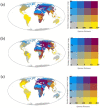Language barriers in global bird conservation
- PMID: 35442973
- PMCID: PMC9020734
- DOI: 10.1371/journal.pone.0267151
Language barriers in global bird conservation
Abstract
Multiple languages being spoken within a species' distribution can impede communication among conservation stakeholders, the compilation of scientific information, and the development of effective conservation actions. Here, we investigate the number of official languages spoken within the distributions of 10,863 bird species to identify which species might be particularly affected by consequences of language barriers. We show that 1587 species have 10 languages or more spoken within their distributions. Threatened and migratory species have significantly more languages spoken within their distributions, when controlling for range size. Particularly high numbers of species with many languages within their distribution are found in Eastern Europe, Russia and central and western Asia. Global conservation efforts would benefit from implementing guidelines to overcome language barriers, especially in regions with high species and language diversity.
Conflict of interest statement
The authors have declared that no competing interests exist.
Figures




Similar articles
-
Language barriers in conservation: consequences and solutions.Trends Ecol Evol. 2025 Mar;40(3):273-285. doi: 10.1016/j.tree.2024.11.003. Epub 2024 Dec 20. Trends Ecol Evol. 2025. PMID: 39706729 Review.
-
Parallel extinction risk and global distribution of languages and species.Nature. 2003 May 15;423(6937):276-9. doi: 10.1038/nature01607. Nature. 2003. PMID: 12748639
-
Bird naming systems by Akan people in Ghana follow scientific nomenclature with potentials for conservation monitoring.J Ethnobiol Ethnomed. 2015 Oct 31;11:75. doi: 10.1186/s13002-015-0062-y. J Ethnobiol Ethnomed. 2015. PMID: 26520061 Free PMC article.
-
Global distribution and drivers of language extinction risk.Proc Biol Sci. 2014 Oct 22;281(1793):20141574. doi: 10.1098/rspb.2014.1574. Proc Biol Sci. 2014. PMID: 25186001 Free PMC article.
-
Enhancing monitoring and transboundary collaboration for conserving migratory species under global change: The priority case of the red kite.J Environ Manage. 2022 Sep 1;317:115345. doi: 10.1016/j.jenvman.2022.115345. Epub 2022 May 26. J Environ Manage. 2022. PMID: 35642814 Review.
Cited by
-
Academic publishing requires linguistically inclusive policies.Proc Biol Sci. 2024 Mar 13;291(2018):20232840. doi: 10.1098/rspb.2023.2840. Epub 2024 Mar 13. Proc Biol Sci. 2024. PMID: 38471557 Free PMC article.
-
Tapping into non-English-language science for the conservation of global biodiversity.PLoS Biol. 2021 Oct 7;19(10):e3001296. doi: 10.1371/journal.pbio.3001296. eCollection 2021 Oct. PLoS Biol. 2021. PMID: 34618803 Free PMC article.
References
-
- Nations United. Intergovernmental Science-Policy Platform on Biodiversity and Ecosystem Services (IPBES). Nature’s Danger Decline ‘Unprecedented’ Species Extinction Rates ‘Accelerating’ Curr. 2019. doi: 10.1016/j.gloenvcha.2014.04.002 - DOI
-
- Kark S, Tulloch A, Gordon A, Mazor T, Bunnefeld N, Levin N. Cross-boundary collaboration: Key to the conservation puzzle. Curr Opin Environ Sustain. 2015;12: 12–24. doi: 10.1016/j.cosust.2014.08.005 - DOI
Publication types
MeSH terms
LinkOut - more resources
Full Text Sources

